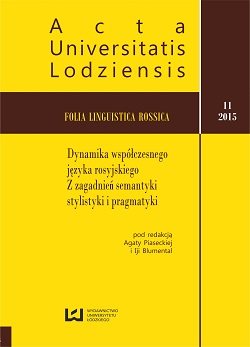New borrowings in Russian: functional and methodological aspects
DOI:
https://doi.org/10.18778/1731-8025.11.07Keywords:
foreign words, borrowingsAbstract
The influx of a huge number of foreign words to the Russian language – at the text, speech and system levels – that began in the late XX century, observed today, has created serious problems faced by ordinary native speakers as well as linguists. Genetic typology; thematic typology; classification based on the degree of development of foreign language words; typology, which is based on the principle of the nomination – a sign of the presence / absence of an equivalent in the language of the recipient are the best known in the native linguistics. Due to significant changes observed in the nature of borrowing and the new foreign words’ development in the Russian language, there is a question of the facts borrowing traditional theory’s adequacy to language interaction. The numerous examples’ analysis of the foreign words usage shows that quite often their different ranks are deprived of their individuality. This is reflected in the fact that the properties that were considered typical for one category of words we find in the other, and vice versa. This is confirmed by a number of facts: the active use of Latin at foreign words’ registration, word-formation activity of not only borrowed, but also other ranks of foreign words, their functional convergence in modern texts.
References
Верещагин Е. М., Костомаров В. Г. (2005), Язык и культура, Москва, 1308 с.
Google Scholar
Воронина А. В. (2010), Изучение иноязычных заимствованных слов на уроках русского языка в начальной школе, «Диссертация … кандидата филологических наук», Ярославль, с. 103–116.
Google Scholar
Крысин Л. П. (1968), Иноязычные слова в современном русском языке, Москва, 208 с.
Google Scholar
Крысин Л. П. (2007), Толковый словарь иноязычных слов, Москва, 944 с.
Google Scholar
Маринова Е. В. (2011), Адаптация иноязычной лексики на современном этапе: новые явления и тенденции, «Вестник Нижегородского университета им. Н. И. Лобачевского», №6 (2), с. 399–403.
Google Scholar
Маринова Е. В. (2008), Иноязычные слова в русской речи XX-начала XXI в.: проблемы освоения и функционирования, Москва, 495 с.
Google Scholar
Маринова Е. В. (2012), Современное состояние проблемы «свое vs. чужое» в отечественной лексикологии, «Научный диалог», выпуск 8, Екатеринбург, с. 59–70.
Google Scholar
Скляревская Г. Н., Предисловие, [в:] Толковый словарь русского языка начала XXI. Актуальная лексика, ред. Г. Н. Скляревская, Москва, 2006, с. 5–26.
Google Scholar
Сорокин Ю. С. (1965), Развитие словарного состава русского литературного языка в 30-90-е гг. XIX века, Москва – Ленинград, 566 с.
Google Scholar
Толковый словарь современного русского языка. Языковые изменения конца XX столетия (2001), ред. Г. Н. Скляревская, Москва, 944 с.
Google Scholar
Шадурский И. В. (1975), Тематическое изучение лексики, [в:] Методы изучения лексики, Минск, с. 48–52.
Google Scholar
Downloads
Published
How to Cite
Issue
Section
License

This work is licensed under a Creative Commons Attribution-NonCommercial-NoDerivatives 4.0 International License.









